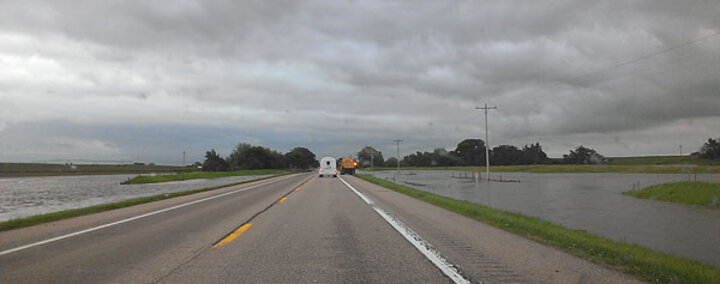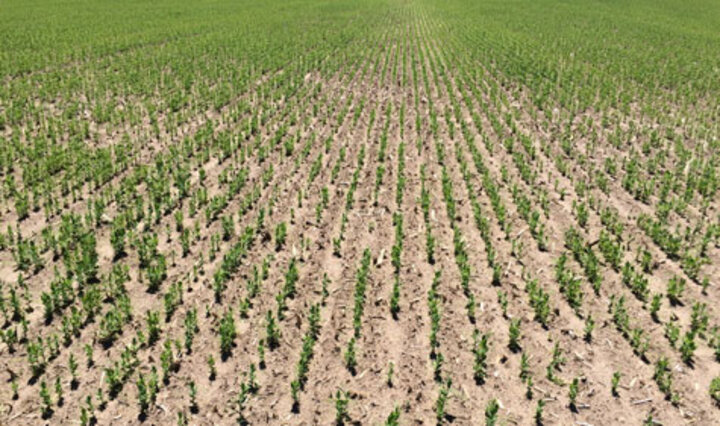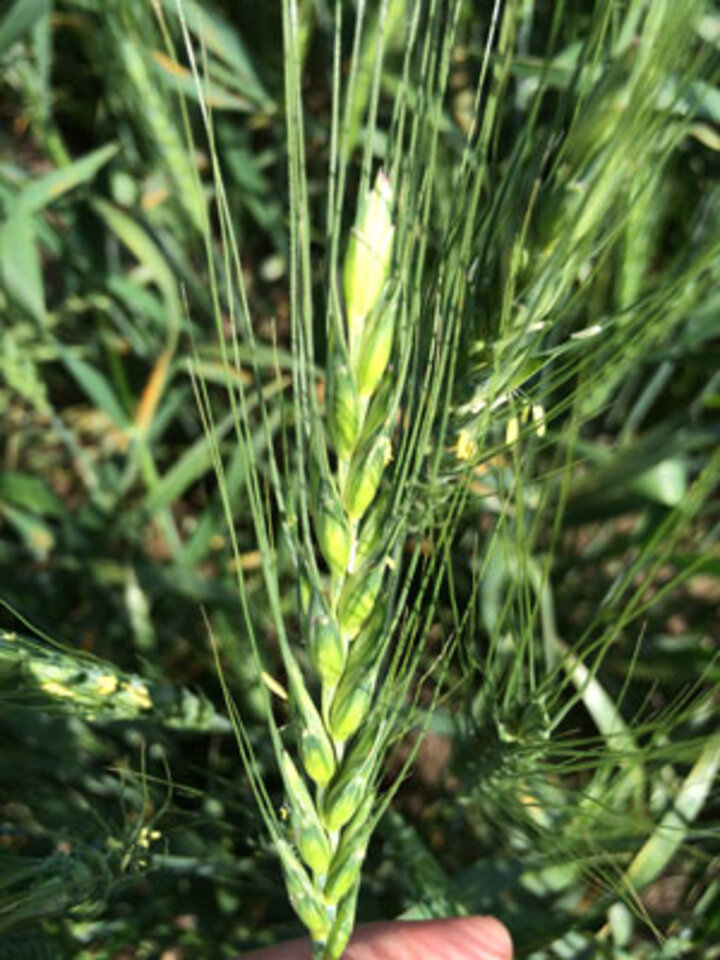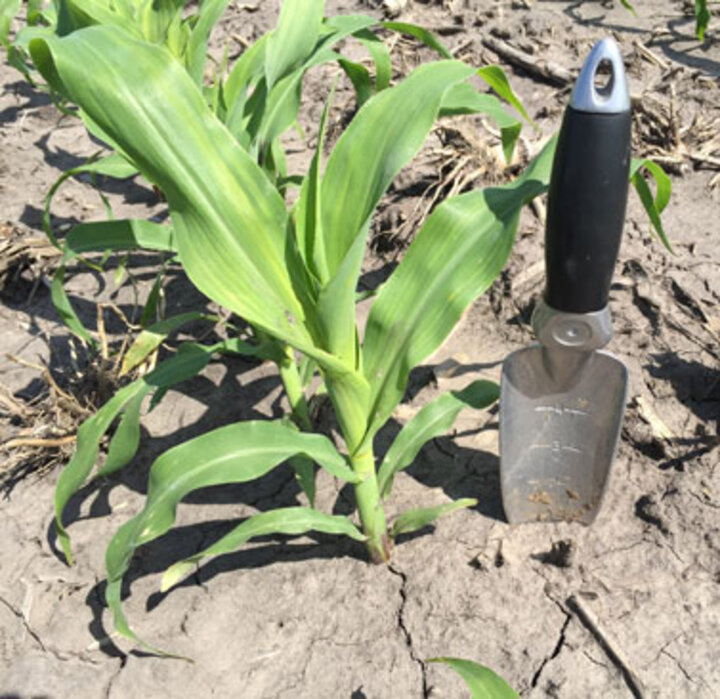

Heavy rains and hail in Clay County Wednesday and Thursday evenings damaged an estimated 30% of the county's crops. (Photos by Jenny Rees)


Tony Adesemoye, Extension Plant Pathologist at the West Central REC, North Platte: Symtoms of freeze and disease damage of soybeans can look very similar. The symptoms of pathogens that will cause seedling diseases at this time of the year were not found in the roots of these seedlings (photo, right) when they were dug up. Typical symptoms of soybean seedling diseases with the recent environmental conditions include:
- discoloration of the roots,
- root rot, that is, a rotted appearance,
- seedlings that can be easily pulled from the ground due to a reduced root system,
- a hypocotyl with water-soaked lesions, or
- reddish brown sunken lesions on the hypocotyl. (June 5, 2015)
Jeff Bradshaw, Extension Entomologist at the Panhandle REC, Scottsbluff: Wet cool weather in the Panhandle is supporting a surge in the wheat stem sawfly population. Emergence this year was probably about 1 to 1.5 weeks earlier than normal, likely due to the warm spell we had in March and April, and abundance is high. A crop consultant checking dryland wheat fields near Berea found about 100 sawfly adults per square foot, a high number in wheat. With the rain giving our wheat (as well as our cheat grasses) so much vegetative growth, we are going to see a very health crop of sawflies this year. (June 5, 2015)


(Left) Varietal test plots of field peas in southwest Nebraska show distinct differences. (Right) Yellowish appearance of field peas is not a concern when they are well nodulated. A few days of sunshine will make all the difference. (Photos by Strahinja Stepanovic)

Strahinja Stepanovic, Extension Educator in Perkins, Chase and Dundy Counties: Wet conditions in southwest Nebraska continue to interfere with timely panting and spraying operations. Wheat is in good condition, with the exception of stripe rust being severe in some areas of Chase County. It's time to look at disease tolerance characteristics of variety planted last fall and consider preventive and curative fungicide applications to avoid catastrophic yield losses. Rain has also increased our risk for Fusarium Head Blight. Therefore, products that work well on both stripe rust and head scab such as Caramba and Prosaro can be used while wheat is at flowering stage.
Corn planting is 90% done; V3-V4 corn is also commonly found in the area. Fields show signs of farmers struggling to make timely herbicide applications. Aerial herbicide application is recommended if weeds are growing out of optimal control time. In western Perkins and Chase counties pea size hail damage is observed in corn. Research has shown that hail injury on V2 corn is not likely to cause yield losses. Soybean planting is still in progress (about 35% done). Grain sorghum planting is about 30% done. Field peas are at V6-V8 and look yellowish due to lack of sunshine. Farmers should not be concerned, however, as nodules inhabited with nitrogen-fixing bacteria are present and active. (June 2, 2015)John Thomas, Extension Educator in Box Butte County: About 90-95% of the corn was planted before the wet spell and most has come up. Due to the wet conditions, very few dry edible beans have been planted and growers are anxious to get them in the ground. Sugar beets got off to a good start, but cool wet conditions and a couple early frosts will make it an average crop. Wheat is coming along, with condition estimated at 10% excellent, 60% good, 20% fair, and 10% poor. We aren't seeing stripe rust yet. (June 2, 2015)
Tony Adesemoye, Extension Plant Pathologist at the West Central REC: Wheat disease is severe in some areas of south central and southwest Nebraska, (See CW article on wheat disease for details.) (June 2, 2015)
Todd Whitney, Extension Educator in Hamilton County: We're generally good on moisture, although a couple pivots were started briefly. We're putting in water mark sensors. Corn and soybeans are planted and average corn is at V5 growth stage. Soybeans are coming along well. (June 2, 2015)
Jennifer Rees, Extension Educator in Clay County: Conditions are dry here and we could use a shot of rain. Some pivots were started to address crusting issues and activate herbicides. We're seeing so much disease in wheat this year. A lot of growers didn't spray in time; other did spray early to protect their flag leaves, but were hit by stripe rust when the residual effect ran out. Another fungicide application could save the crop, but growers may want to review the economics. We're finding some wireworms. First cutting of alfalfa is underway. (June 2, 2015)
Tyler Williams, Extension Educator in Lancaster County: Field conditions are relatively dry here, but variable. Corn looks good, but some soybean fields still need to be planted. A lot of the alfalfa and hay is down. (June 2, 2015)
Gary Lesoing, Extension Educator in Nemaha County: Due to wet conditions, some growers are just getting into their fields and others are just getting back in. About 85% of the corn is in, but very few soybeans. Corn is at the 3-4 leaf stage and looks yellow due to lack of sunshine. Only a few beans are up. We don't have a lot of wheat, but the treated wheat looks good. Some have taken their first cutting of alfalfa, but a few fields have gone down. I hope the rain holds off until this harvest is in. (June 2, 2015)



Nathan Mueller, Extension Educator in Dodge County: Based on a tour of fields in Dodge and Washington County over the last couple of days, corn is pretty much planted and some has been replanted. Some river-bottom land are too wet to plant. We have seen some damping off in corn, but at low rates (less than 1%) We're not seeing too many disease issues in soybean, but have seen a few bean leaf beetles, less than one for every five plants. Growers are taking their first cutting of alfalfa.
We're seeing some phosphorus deficiency in corn on ridges and terraces. Corn growth stage ranges from unplanted to V5 with V3 being average. Soybeans range from unplanted to V2 with most falling at the VE or VC growth stage. Overall, crop conditions are better than might be expected. Given how wet it has been during planting, it wouldn't be surprising to get some root development issues in corn. (See Mueller's blog at Crop Tech Cafe for more details and photos.) (June 2, 2015)
Keith Jarvi, Extension Educator in Dakota, Dixon and Thurston: We could use a soaker up her. As you move west of Wayne, the rains have been pretty spotty. Soybeans have emerged. Corn looks good overall, ranging in growth from the 2-3 leaf stage to the 4-5 leaf stage. It's been pretty cool around here and we didn't hit 70°F until June 1. Shapiro: The outbreak of avian flu in commercial poultry flocks and its potential economic impact on the community– it's one of the areas big employers -- is a key discussion topic here. This industry supplies a lot of manure to farmer fields. We've worked hard the past 20 years to help growers learn how to use it properly, and they've grown to like it. Now if they have to shift to something else, it may have longer term impacts for them. (June 2, 2015)

Gary Stone, Extension Educator at the Panhandle REC, Scottsbluff: Snow melt runoff continues in the high country of Wyoming and Colorado at the headwaters of the North Platte River. Runoff will be less this year due to less than average snowpack in this region, but with the above average precipitation these past few weeks across southeast Wyoming and the Panhandle of Nebraska, the North Platte and Laramie Rivers are flooding. There are lowland flood warnings for portions of eastern Wyoming and the Nebraska Panhandle along the Laramie and North Platte rivers through Wednesday of this week. Releases from Glendo Reservoir in Wyoming have been cut back to help alleviate this situation; Glendoe is now in the "flood pool" for water storage. The two main reservoirs on the North Platte River average about 73% capacity at this time and water releases for the irrigation districts are expected to be normal for this growing season. (June 2, 2015)
Monte Vandeveer, Extension Educator in Otoe County: A good share of growers did not quite finish their corn plantings prior to this week. However, with a clear window over the last few days, most should be nearly finished by now. Earliest corn planted is only 4-5 inches tall; plenty of moisture, but cool and cloudy weather seems to have slowed growth. Soybean planting is behind schedule after very little planting during May. Haven't seen any alfalfa cut yet; wet conditions are scaring hay producers who fear it won't cure. (June 1, 2015)
